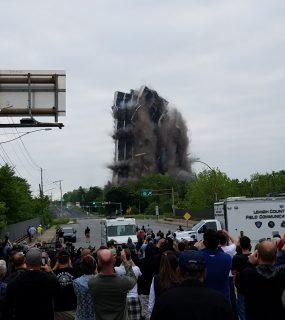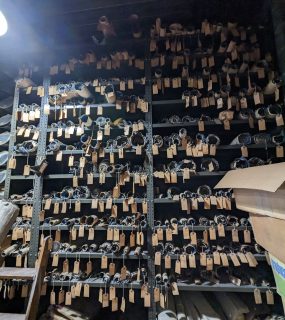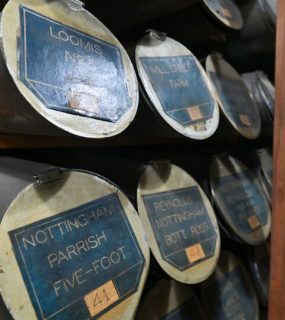BETHLEHEM, Pa. – For residents of the Lehigh Valley in Pennsylvania, the imminent implosion of Martin Tower, once the corporate headquarters of Bethlehem Steel Corporation, has been a hot-button topic. Locals have mixed views on the behemoth, from those that miss the good ol’ days of ‘the Company’ to those who see the building as a symbol of corporate grandeur. Love it or hate it, Martin Tower has been a landmark in Bethlehem, and its place in the skyline will be missed.
But not as many people are aware of the Tower’s namesake – Edmund F. Martin, former chairman of Bethlehem Steel. In his nearly five decades working for the Company, Martin moved from a machinist’s helper to the top executive in the corporation, once the world’s second largest steelmaker, and he left an indelible legacy apart from the Tower at Eighth and Eaton Avenues.
Martin, born in Chicago in the early years of the twentieth century, first felt the pull of steel as a boy of 14. He reported to the Bethlehem Globe-Times later that he was invited to tour a steel facility and “when [he] saw those blast furnaces, open hearths and rolling mills, [he] knew right then [he’d] never seriously consider any other field.” At the age of 15 his family moved to the East Coast after his father accepted a position at a manufacturing firm in Orange, N.J. Soon after, Martin attended the Stevens Institute of Technology, in Hoboken, N.J., where he managed
the baseball team and played on the football’s scrimmage team. Over the summers, he honed his skills working as an assistant to machinists and toolmakers.
“In only a few years, Martin rose from vice president, to president, to vice chairman, and, finally, to chairman and CEO of Bethlehem Steel Corporation in 1964, then 17th on the Fortune 500 of Americas’ largest companies.”
At the young age of 19, Martin graduated and in June 1922 moved to Bethlehem, Pa. He joined the first successful iteration of Bethlehem Steel’s famous “Loop Course,” which was a management training program for college graduates, one of the earliest such programs in American business. From 1922-1924, Martin worked as a repairman’s helper in the roll shop of the Saucon Division of the local Bethlehem Plant. During this time, he worked 12-hour shifts, six days a week. In 1924, after several supervisors were fired for playing cards in the mill, Martin was promoted to the position of foreman of the 12- and 18-inch mills. By 1928 he was the superintendent of those mills. Although he was dedicated to his rising position at work, Martin also found personal fulfillment. On November 22, 1926, he married Frances Taylor, whom he had met on his first day in Bethlehem four years before. The couple welcomed two children in their life shortly after, named Bettie and Barbara.
During the Second World War, Bethlehem Steel boomed. Its workforce swelled to an all-time high of more than 300,000 and Bethlehem produced over 1100 ships during that period, in history’s largest shipbuilding program. Martin worked relentlessly as the assistant superintendent of the Saucon Division. After the conclusion of the war, Martin and his family moved to northern New York, as he took the position of assistant general manager at
Bethlehem’s Lackawanna Plant, just outside of Buffalo. In 1950 he became general manager and Bethlehem executives soon began noticing his initiative during this period. In his eight years as general manager, the plant increased its annual capacity by over 2,000,000 tons, and taking the rank of third-largest steel plant in the country.
Martin’s success spoke for itself, and he was called back to Bethlehem in early 1958 to become the vice president of operations. In only a few years, Martin rose from vice president, to president, to vice chairman, and, finally, to chairman and CEO of Bethlehem Steel Corporation in 1964, then 17th on the Fortune 500 of Americas’ largest companies. Martin held this position until his retirement at 68 in November 1970.
During his career, Martin was awarded numerous honors, including honorary doctorates from the University of Buffalo, Moravian College, Stevens Institute of Technology, Valparaiso University and Lehigh University, the rank of Knight Commander of the Royal Order of the North Star by the Swedish government, and the Grand Band of the Order of the Star of Africa by the Liberian government. Additionally, in April 1967, Martin took the mantle of chair of the American Iron and Steel Institute and in 1969, received its Elbert H. Gary Memorial Medal. The Pennsylvania Society also awarded him the Society’s Gold Medal for Distinguished Achievement. In 1963 and 1967, he advised, respectively, Presidents Kennedy and Johnson on domestic steel policy, and also served as chairman of President Nixon’s National Pollution Control Council.
Martin’s career also was a time of great expansion for Bethlehem Steel. In the early 1960s, the Homer Research Laboratories were established on South Mountain in Bethlehem, Pa., a showplace in the industry for the development of steelmaking technology. And in 1962, Bethlehem began developing its Burns Harbor Plant, just south of Chicago on the shoreline of Lake Michigan in Northwest Indiana. The ultra-modern and highly efficient Burns Harbor Plant was the last steel plant to be built in America from the ground up as a fully integrated steel mill and, at the time, was the largest private construction project in the history of the United States. Burns Harbor, which would eventually become Bethlehem’s largest and most important steelmaking facility represented Bethlehem’s first major strategic move into the important Midwestern steel market after Bethlehem’s second failed attempt to acquire Youngstown Sheet & Tube.
By Martin’s retirement in 1970, the Company had 22,000 local employees on its payroll – about 125,000 worldwide. His management style, as characterized by his successor, Stewart S. Cort, served as a bridge between the “oldschool” traditional style of leadership and the newer team-oriented style. Martin’s time at Bethlehem Steel was characterized by growth, and he used his platform to encourage Bethlehem citizens and the steel industry to further causes such as education, alleviation of poverty, and environmentalism.
Martin’s local legacy went beyond his time at Bethlehem Steel. He also served, at various times as a member of the Bethlehem Chamber of Commerce, the president of Historic Bethlehem, Inc., a trustee for Lehigh University and St. Luke’s Hospital, and a member of the Saucon Valley Country Club, among many other organizations. But his main legacy, at least until 2019, has been Martin Tower. In 1972, two years after Martin’s retirement, his namesake Tower opened as Bethlehem Steel Corporation’s corporate headquarters and at 332 feet, immediately became the tallest building in the Lehigh Valley, edging out Allentown’s PPL Building by 10 feet. With the exception of Harrisburg’s 341-foot Market Street Building, it’s also the tallest building in Pennsylvania outside of Philadelphia and Pittsburgh. At 21 floors, the Tower also offered sweeping vistas of the entire Lehigh Valley and is visible from large portions of the greater Bethlehem area. The iconic tower is scheduled to be imploded on May 19, to make way for redevelopment of the site.
Although Bethlehem Steel declared bankruptcy in 2001 and was sold in 2003, its indelible place in Bethlehem and the world beyond are undeniable. Attendees of festivals like Musikfest and Christkindlmarkt can’t help but be awed by the dramatic backdrop of the blast furnaces of the now shuttered local Bethlehem Plant, but Martin Tower, on its 53 acres in west Bethlehem definitely stands out. To many, the implosion of the Tower is symbolic of the fall of the company and Bethlehem’s recent resurgence. However, the legacy of Edmund F. Martin and the once great company that built, transported and defended America, will live on long after the Tower falls.



